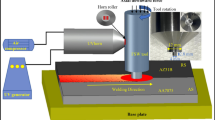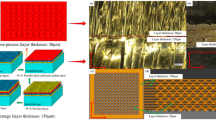Abstract
SiCf/SiC ceramic matrix composites are widely used in high-tech fields such as aerospace and usually processed by grinding methods. In the conventional machining (CON-M), the cutting force during machining is increased due to the hard and brittle characteristics of the material, which affects the surface topography after machining. As a new machining method, longitudinal-torsional coupled rotary ultrasonic machining (LTC-RUM) can effectively reduce the cutting force and improve the surface topography after machining. The machining characteristics of SiCf/SiC ceramic matrix composites in LTC-RUM was investigated to improve the service performance of the material, and reduce the energy consumption. However, relatively few studies have been performed on the machinability of SiCf/SiC ceramic matrix composites by LTC-RUM. This paper studies the cutting force and surface topography during machining by experimental methods. Firstly, the motion characteristics of a single abrasive grain during LTC-RUM are analyzed, and the cutting characteristics of the abrasive grain under the both machining conditions are obtained. Secondly, the effects of spindle speed, feed rate, cutting depth, and ultrasonic amplitude on cutting force and surface roughness were obtained by experimental exploration of CON-M and LTC-RUM. Compared with CON-M, the cutting force is reduced by 64.4%, the surface roughness is reduced by 44.5% under LTC-RUM, and the surface topography is significantly improved. The results of this study provide a theoretical and experimental basis for machining SiCf/SiC ceramic matrix composites.













Similar content being viewed by others
Data availability
All data generated or analyzed during this study are included in the present article.
References
Yuan Q, Song YC (2016) Research and development of continuous sic fibers and SiCf/SiC composites. J Inorg Mater 31:1157–1165. https://doi.org/10.15541/jim20160119
Jiao F, Li YX, Niu Y, Zhang ZQ, Bie WB (2023) A review on the drilling of CFRP/Ti stacks: machining characteristics, damage mechanisms and suppression strategies at stack interface. Compos Struct 305. https://doi.org/10.1016/j.compstruct.2022.116489
Vinci A, Silvestroni L, Gilli N, Zoli L, Sciti D (2022) Advancements in carbon fibre reinforced ultra-refractory ceramic composites: effect of rare earth oxides addition. Compos Part a Appl Sci Manuf 156. https://doi.org/10.1016/j.compositesa.2022.106858
Ouyang Q, Wang YF, Xu J, Li YS, Pei XL et al (2022) Research progress of SiC fiber reinforced SiC composites for nuclear application. J Inorg Mater 37:821–840. https://doi.org/10.15541/jim20220145
Zhang XF, Zhou KS, Liu M, Meng CM, Deng CG, Niu SP, Xu SM (2017) Oxidation and thermal shock resistant properties of al-modified environmental barrier coating on SiCf/SiC composites. Ceram Int 43:13075–13082. https://doi.org/10.1016/j.ceramint.2017.06.167
Leyens C, Hausmann J, Kumpfert J (2003) Continuous fiber reinforced titanium matrix composites: fabrication, properties and applications. Adv Eng Mater 5:399–410. https://doi.org/10.1002/adem.200310093
Han X, Gao XG, Song YD (2019) Effect of heat treatment on the microstructure and mechanical behavior of SiC/SiC mini-composites. Mater Sci Eng a Struct Mater 746:94–104. https://doi.org/10.1016/j.msea.2018.12.118
Dong SM, Katoh Y, Kohyama A (2003) Preparation of SiC/SiC composites by hot pressing, using tyranno-sa fiber as reinforcement. J Am Ceram Soc 86:26–32. https://doi.org/10.1111/j.1151-2916.2003.tb03272.x
Chen J, Gu L, He G (2020) A review on conventional and nonconventional machining of SiC particle-reinforced aluminium matrix composites. Adv Manuf 8:279–315. https://doi.org/10.1007/s40436-020-00313-2
Nguyen T, Liu D, Thongkaew K, Li H, Qi H, Wang J (2018) The wear mechanisms of reaction bonded silicon carbide under abrasive polishing and slurry jet impact conditions. Wear 410-411:156–164. https://doi.org/10.1016/j.wear.2018.06.001
An QL, Chen J, Ming WW, Chen M (2021) Machining of SiC ceramic matrix composites: a review. Chin J Aeronaut 34:540–567. https://doi.org/10.1007/s40436-020-00313-2
You KY, Yan GP, Luo XC, Gilchrist MD, Fang FZ (2020) Advances in laser assisted machining of hard and brittle materials. J Manuf Process 58:677–692. https://doi.org/10.1016/j.jmapro.2020.08.034
Dong ZG, Zhang HT, Kang RK, Ran YC, Bao Y (2022) Mechanical modeling of ultrasonic vibration helical grinding of SiCf/SiC composites. Int J Mech Sci 234. https://doi.org/10.1016/j.ijmecsci.2022.107701
He JY, Su HH, Qian N, Xu PF (2022) Machining performance analysis of rotary ultrasonic-assisted drilling of SiCf/SiC composites. Crystals (Basel) 12. https://doi.org/10.3390/cryst12111658
Wang X, Zimmer K, Ehrhardt M, Zhang FY, Wang J et al (2022) One-step in-situ low damage etching of SiC/SiC composites by high-temperature chemical-assisted laser processing. Ceram Int 48:34472–34482. https://doi.org/10.1016/j.ceramint.2022.08.028
Zhao B, Bie WB, Wang XB, Chen F, Wang Y, Chang BQ (2019) The effects of thermo-mechanical load on the vibrational characteristics of ultrasonic vibration system. Ultrasonics 98:7–14. https://doi.org/10.1016/j.ultras.2019.05.005
Zhang YB, Li CH, Ji HJ et al (2017) Analysis of grinding mechanics and improved predictive force model based on material-removal and plastic-stacking mechanisms. Int J Mach Tools Manuf 122:81–97. https://doi.org/10.1016/j.ijmachtools.2017.06.002
Yang YY, Yang M, Li CH et al (2023) Machinability of ultrasonic vibration-assisted micro-grinding in biological bone using nanolubricant. Front Mech Eng 18. https://doi.org/10.1007/s11465-022-0717-z
Gao T, Zhang XP, Li CH et al (2020) Surface morphology evaluation of multi-angle 2d ultrasonic vibration integrated with nanofluid minimum quantity lubrication grinding. J Manuf Process 51:44–61. https://doi.org/10.1016/j.jmapro.2020.01.024
Jia DZ, Li CH, Zhang YB et al (2019) Experimental evaluation of surface topographies of nmql grinding zro2 ceramics combining multiangle ultrasonic vibration. Int J Adv Manuf Technol 100:457–473. https://doi.org/10.1007/s00170-018-2718-y
Jiang J, Wang S, Lin B, Li H (2018) Experimental investigation on filing in ultrasonic vibration process of Cf/SiC composites. Mech Sci Technol Aerospace Eng 37:1246–1252. https://doi.org/10.13433/j.cnki.1003-8728.20180004
Li H (2015) Study on the ultrasonic vibration filing of Cf/SiC composites. Tianjin University
Jiang QJ (2015) Research on the technology of ultrasonic torsional vibration assisted milling C/SiC composites. Nanchang Hangkong University
Ding K, Fu YC, Su HH, Cui FF, Li QL, Lei WN, Xu HY (2017) Study on surface/subsurface breakage in ultrasonic assisted grinding of C/SiC composites. Int J Adv Manuf Technol 91:3095–3105. https://doi.org/10.1007/s00170-017-0012-z
Li YC, Ge X, Wang H, Hu YB, Ning FD, Cong WL, Ren CZ (2019) Study of material removal mechanisms in grinding of C/SiC composites via single-abrasive scratch tests. Ceram Int 45:4729–4738. https://doi.org/10.1016/j.ceramint.2018.11.165
Yang YY, Qu SS, Gong YD (2021) Investigating the grinding performance of unidirectional and 2.5D-C/SiCs. Ceram Int 47:5123–5132. https://doi.org/10.1016/j.ceramint.2020.10.090
Xiong YF, Liu C, Wang WH, Jiang RS, Huang B, Wang DH, Zhang SG (2023) Assessment of machined surface for SiCf/SiC ceramic matrix composite during ultrasonic vibration-assisted milling-grinding. Ceram Int 49:5345–5356. https://doi.org/10.1016/j.ceramint.2022.10.058
Zhao F (2019) Experimental study on ultrasonic assisted grinding of SiCf/SiC composites. Dalian University of Technology
Zhang ZK, Yuan SM, Li QL, Gao XX, Ouyang XL, Luo Y (2022) Investigation on the machined surface quality and removal mechanism of SiCf/SiC composites in ultrasonic-assisted grinding. Int J Adv Manuf Technol 123:4427–4445. https://doi.org/10.1007/s00170-022-10469-9
Yin JF, Xu JH, Ding WF, Su HH, Gao Y, He JY (2022) Experimental study of single grain grinding for SiCf/SiC ceramic matrix composites. China Mechanical Engineering 33:1765–1771. https://doi.org/10.3969/j.issn.1004-132X.2022.15.001
Zhang MH, Xia ZW, Shan CW, Luo M (2023) Analytical model of cutting force for ultrasonic-assisted grinding of Cf/SiC composites. Int J Adv Manuf Technol. https://doi.org/10.1007/s00170-023-11257-9
Qi YC (2019) Study on ultrasonic grinding mechanism of carbon fiber reinforced composites. Dalian University of Technology
Chen F, Bie W, Wang X, Zhao B (2022) Longitudinal-torsional coupled rotary ultrasonic machining of ZrO2 ceramics: an experimental study. Ceram Int 48:28154–28162. https://doi.org/10.1016/j.ceramint.2022.05.398
Zhang MH, Pang ZX, Jia YX, Shan CW (2022) Understanding the machining characteristic of plain weave ceramic matrix composite in ultrasonic-assisted grinding. Ceram Int 48:5557–5573. https://doi.org/10.1016/j.ceramint.2021.11.100
Funding
This work was financially supported by the National Natural Science Foundation of China (No. 52005164), the Key R&D and Promotion Program (Science and Technology) in Henan Province, China (Nos. 222103810043, 222102220003, 232102221018), and PhD Research Start-up Fund Project of Pingdingshan University of China (No.PXY-BSQD-2022001).
Author information
Authors and Affiliations
Contributions
Jiangwei Jin, Wenbo Bie and Fan Chen conceived the analysis and wrote the manuscript. Xiaobo Wang and Bo Zhao provided supervisions on experimentation and manuscript preparation. Jiangwei Jin, Wenbo Bie and Fan Chen collected the data and revised the manuscript. Jiangwei Jin, Wenbo Bie, and Fan Chen performed the experiment. The authors discussed each reference paper together and contributed useful ideas for this manuscript.
Corresponding author
Ethics declarations
Ethics approval
The article follows the guidelines of the Committee on Publication Ethics (COPE) and involves no studies on human or animal subjects.
Consent to particfipate
Not applicable.
Consent for publication
Not applicable.
Competing interests
The authors declare no competing interests.
Additional information
Publisher’s note
Springer Nature remains neutral with regard to jurisdictional claims in published maps and institutional affiliations.
Rights and permissions
Springer Nature or its licensor (e.g. a society or other partner) holds exclusive rights to this article under a publishing agreement with the author(s) or other rightsholder(s); author self-archiving of the accepted manuscript version of this article is solely governed by the terms of such publishing agreement and applicable law.
About this article
Cite this article
Jin, J., Wang, X., Bie, W. et al. Machinability of SiCf/SiC ceramic matrix composites using longitudinal-torsional coupled rotary ultrasonic machining. Int J Adv Manuf Technol 131, 2465–2476 (2024). https://doi.org/10.1007/s00170-023-11792-5
Received:
Accepted:
Published:
Issue Date:
DOI: https://doi.org/10.1007/s00170-023-11792-5




